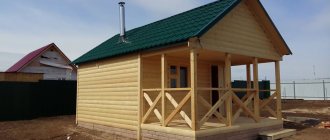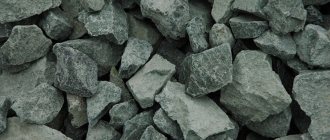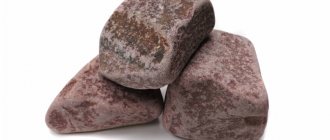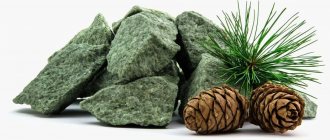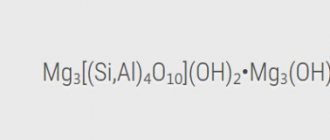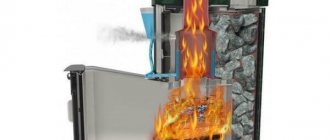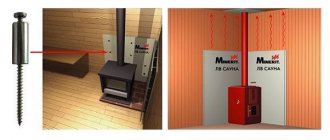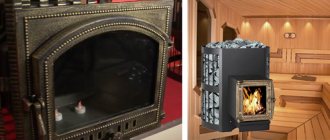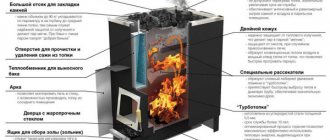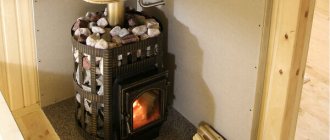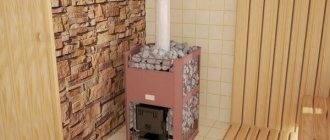But the stone in the bathhouse has quite a lot of tasks and conditions of existence. specific. It would be possible to talk separately about what requirements a bathhouse places on stones, but it would be more useful to consider them in connection with the specific properties of a gabbro-diabase stone for a bathhouse.
What is the breed
As you can already judge from the name, this stone is a “transitional” link between diabase and gabbro. According to its characteristics, the rock is close to basalt and granite. It is a gabbro-diabase stone of a dark gray or greenish color. It contains, for example, minerals such as:
- titanomagnetite;
- plagioclase;
- pyroxenes;
- amphiboles.
None of these types of minerals release harmful substances into the air. And this is, of course, a big advantage of gabbro-diabase as a stone used in industry, construction and everyday life.
Properties and contraindications of the stone
We will get to contraindications below; in general, this formulation of the question should be given special attention. But there’s nothing wrong with properties—all things have unique sets of properties that make them either suitable or unsuitable for the tasks assigned to them by man.
What is good about its mineral and chemical composition?
87% of the entire rock mass of the Earth is silicates or silicon compounds. But diversity from such chemical uniformity is obtained due to different percentages of silica and other oxides, as well as rarer impurities under different conditions of crystal formation.
As for the chemical composition of gabbro-diabase, it is practically indistinguishable from the chemical composition of basalt - this is the same magma of basic (=alkaline) composition, which crystallized at a different depth than basalt. The latter circumstance is responsible for which crystals are formed, and whether they are formed at all.
Here is the average percentage chemical composition of basalt :
- Al₂О₃ 12-17%
- MgO 7-15%
- CaO 6-13%
- FeO 4-14%
- Fe₂О₃ 0.5-11%
- Na₂О 1.5-3.5%
- TiO₂ 1.0-2.5%
- К₂О 0.1-2%
- Р₂О₅ up to 0.6%
- MnO up to 0.3%
You see that it all consists of fairly inert oxides. Bath temperatures cannot destroy them; they were formed at higher temperatures. So for a bathhouse, the chemical properties of gabbro-diabase are essentially indifferent, since they pose neither a threat nor a benefit (may fans of the healing power of stones forgive us - we are not experts in this field).
However, please note: we are talking about an average composition! And it says nothing about, for example, that sulfur - both elemental and in the form of oxides - is one of the components of liquid magma. When cooling, it usually “pulls” metals from the magma, forming, for example, sulfides, which in the form of the same pyrite (iron sulfide) can crystallize inside the future gabbro-diabase.
But it is sulfides that are those impurities that can harm the health of the steamer. If there are stones in the heater with an admixture of sulfides, then with strong heating they will disintegrate, forming sulfur oxides, whose reaction with water forms acids. Inhaling their vapors burns the respiratory tract - it feels like a stinging, sore throat. It also hurts the eyes. In addition, it was not for nothing that the smell of sulfur and its compounds was considered “hellish.”
The presence and amount of sulfides depends on the composition of the magma in a particular area.
Do not think that sulfides are a specific “problem” of gabbro-diabase. In fact, this applies to all igneous rocks. And it will be problematic only in relation to the bathhouse. In general, sulfides are one of the types of ores from which people have been extracting metals since ancient times. In addition to compounds with sulfur, metals are also reduced from oxides.
The time of rock formation is so remote from the present moment that some changes could have occurred to them after the magma solidified. In particular, partial or complete replacement of some minerals could have occurred, which also means a change in chemical composition . But it is unlikely that stone sellers will distinguish between the usual and the substituted rock.
Those who find out the properties of gabbro-diabase as a stone for a bath should pay attention to the deposit, but we will talk about this a little further in this article.
The minerals that make up gabbro-diabase depend on the conditions of its formation. And here we risk first delving into the intricacies of the correct naming of this stone, which precisely depends on the conditions of formation and replacement of some minerals by others. In general, you can read an even more complete article about the properties on our website.
Well, for now let’s just say that typical for gabbro-diabase is the content of approximately equal proportions of plagioclase and colored minerals (usually pyroxenes), as well as small amounts of accompanying ore minerals (in particular, those same sulfides, but they are, in fact, rather an exception than the rule).
The mineral composition of gabbro-diabase for a bath is important only in terms of sulfide content - if there are a lot of them, then you should refuse to purchase such a stone. If it’s a little, you can hope that they will burn out during the first fires.
How to identify sulfides? Quite simply: look on the surface for small cubes and other crystalline formations that have a gray or yellow color and a distinct metallic luster, that is, they shimmer in the light like metal. Yes, that means opening each box and examining the stones.
Bath stone: what physical properties are good for using in a heater?
First of all, let's remember what a stone encounters in a bathhouse and what is expected of it.
The stone can be used either to produce light steam , finely dispersed, that is, superheated (steam temperature above 100 degrees), or simply as a heat accumulator in sauna heaters. To obtain steam from a Russian bath, the stones need to be heated to a temperature of about 400 degrees. But it happens that they heat up even more.
If you even splash boiling water on an overheated stone, there will be a significant temperature difference. There will be an instantaneous transfer of heat to the water, which will evaporate in the form of superheated steam. But the stone will experience a large temperature load , which will destroy it over time.
There are also heaters in batch kilns , in which the stone is directly washed by fire. This heat load further reduces its lifespan, after which it simply crumbles into sand.
In other words, closed heaters and batch kilns require stones that are strong and can withstand high heat and rapid cooling.
Such conditions are best met by stones of igneous origin , which were formed at great depths (more than 2 km). Gabbro-diabase is of igneous origin, but its formation depth is less than 3 km. It is less durable than dunite or jadeite. But its low cost compensates for the inconvenience created by the need to periodically touch the heater.
Those who love saunas know that stones can “shoot” - scatter into pieces inside the stove with a loud bang. What does this come from? Those stones shoot, that is, they split with noise, in which uneven thermal expansion leads to instant destruction. And this depends on the structure and mineral composition. It also depends on the fracturing of the stone itself, but in any case, the active factor is temperature.
Even solids increase their volume under the influence of heat. The smaller the crystals of the stone, the more uniform the structure, the more evenly it will expand. Gabbro-diabase for a bath is good precisely because of its homogeneous structure and small crystals .
Video showing the results of the bulkhead
In general, to summarize: gabbro-diabase is suitable for a bathhouse, but its performance is still not the best, and this, in turn, is compensated by its low price.
Are there any contraindications for using stones in the bath?
Since people ask specifically about “contraindications,” I would like to clarify this issue. Well, it is clear that it came from medicine, and in this sense, of course, cannot be considered at all, unless one indulges in free speculation about the “healing properties of stones.”
But we do not think that any Paracelsus or ancient Chinese doctor, speaking about the effect of stones on the human body, had in mind half a ton of gabbro-diabase in a sauna stove.
Still, you can be rational and consider that the main task of the stone in a sauna stove is the accumulation and transfer of heat. Both ceramics and metal successfully cope with this task. In this sense, it is contraindicated to use... yes, the same marble or granite, that is, something that will not withstand the conditions of heating and cooling.
In general, don't complicate what's simple. The heart and blood vessels are much more influenced by the temperature and humidity ratio in your steam room than the type of stones in the stove.
Where can it be used?
According to sanitary and hygienic standards, gabbro-diabase stone is one of the rocks permitted for use in construction with background radiation not exceeding permissible standards. This material is used quite widely in industry.
One of the features of gabbro-diabase is its interesting fine-grained structure. This stone is polished better than, for example, granite and basalt. Therefore, it is sometimes used as a facing material in the construction of buildings and structures. This breed can also be used:
- for the manufacture of paving stones (for example, exactly this material was used on Red Square in Moscow);
- in precision engineering.
Very often, tombstones are made from such stone. Polished black gabbro-diabase looks very solid and presentable. Therefore, tombstones made from it, like no other, create an appropriate mournful and solemn atmosphere at the burial site. For the manufacture of monuments, Karelian diabase is usually used, which can maintain polish for a long time.
Very often this breed is used to create optimal temperature conditions in baths. That is, they simply put these inexpensive stones in the heaters. Dense gabbro-diabase can retain heat very well and for a long time. In addition, the material is absolutely environmentally friendly.
Like granite, gabbro-diabase is often used in the interiors of apartments and houses. This material is used, for example, to make countertops, railings and window sills. Such products actually look very impressive. In addition, they also have very good performance characteristics.
Physical properties of the rock
The properties of gabbro-diabase, among other things, are distinguished by the following:
- High degree of density - 3.07 g/cm3.
- Compressive strength - 311 MPa.
- Low degree of abrasion - 0.07 g/cm2.
This stone is also characterized by frost resistance. Gabbro-diabase tolerates temperature changes well. The breed can withstand up to 300 cycles of temperature fluctuations without harm. The radioactivity of this material is up to 74 becquerel/kg. In terms of strength, this type of diabase surpasses even granite.
How to mine
Development of gabbro-diabase deposits can be carried out using a variety of technologies. Most often, to extract this material, a hole is first drilled into the rock. Further into it to break the stone can:
- planting explosives;
- pump air under pressure;
- water is supplied and wooden pegs are hammered in (which, swelling, tear the stone).
Gabbro-diabase can also be divided into pieces using, of course, a stone cutter. This technology is currently considered the most expensive and labor-intensive. But at the same time, using it you can extract the highest quality stone.
The unique Karelian gabbro-diabase is currently considered the best in the world. And the deposit itself in this region is one of the largest in the world. The reserves of this type of diabase in Karelia are no less than 4 million m3.
Australian stone is also considered a fairly high-quality material. Its properties are close to Karelian. However, this breed, unfortunately, is much more expensive. The price of Australian diabase is almost three times higher than Karelian diabase.
Mineral mining
Fossil deposits are extensive. The most popular and studied places are the Deccan Plateau in Hindustan, the plain in Argentina, and Brazil. Minerals are mined in Ireland, Finland, and Russia. In the Russian Federation, deposits are located in the Urals, Altai, and in the region of the East Siberian Upland. In South America, monoliths are characterized by voids in which the amethyst is located.
To ensure that the fossil is not damaged during the extraction process and maintains its structure, gentle methods are used. How the first one works:
- First, a hole is drilled into the mineral.
- Then explosives are placed so that the rock blocks remain at their maximum size after the explosion.
Another option is characterized by changing the bomb to use a hydraulic method. The pit is filled with water under pressure. She tears the rock apart.
The latter option implies that the minerals are mined using a professional stone cutter equipped with a diamond-wire sawing mechanism.
Interesting to know! To extract gabbro monolith, special crushing equipment is used, which at the output will allow you to pick up pieces of different sizes and shapes.
Gabbro-diabase for baths: reviews
In everyday life, this stone is most often used in steam rooms. Reviews from bathhouse owners about this breed are mostly positive. The shape of gabbro-diabase is flattened. Therefore, it is very easy to install it in the heater. At the same time, such stones can retain heat for quite a long time.
Bathhouse owners believe that some of the disadvantages of gabbro-diabase are that after prolonged use it begins to crumble. However, this disadvantage is observed in all stones used in steam rooms. Sauna stoves have to be cleaned when using any rocks. Meanwhile, diabase is cheaper than many other breeds intended for steam rooms. Therefore, bathhouse owners do not incur any extra costs when using it in heaters.
When heated very strongly, judging by reviews, this breed is capable of emitting a characteristic odor. But most bathhouse owners do not consider this a disadvantage of stone. The smell, judging by the reviews, of gabbro-diabase is not unpleasant or harmful.
According to the owners of suburban areas, this breed has only two main disadvantages. Firstly, when using a stone in a steam room, you cannot use essential oils. Such substances leave indelible marks on gabbro-diabase. It is also highly recommended not to allow stones of this variety to come into contact with open fire. Because of this, their service life is significantly reduced.
Bath and sauna: how do they differ in terms of stones?
In order to take this point of view, it is not at all necessary to become a stone
